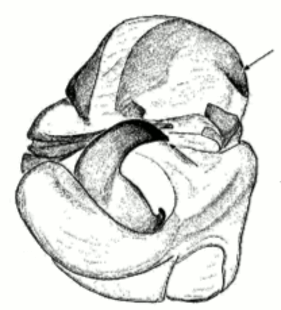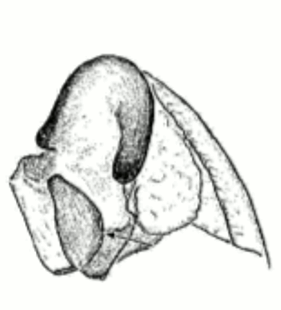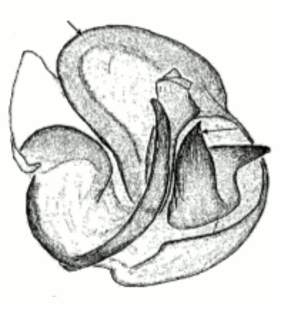Pardosa jergeniensis Ponomarev, 1979
Description
Male
Cymbium black, covered with black setae. Other palpus joints brown, tegulum elongated, tegular apophysis large, with two well developed arms. Bases of embolus subdivided by a thin furrow. Embolus in view from above relatively thick. Terminal apophysis subdivided with a large terminal and a half as long subterminal part. Palea with a distinct ridge. Basal arm of tegular apophysis is subequal in length to the apical arm.
Coloration light. Carapace length 2.5 mm, width 1.9 mm, dark brown, eye field black, median band yellow with clear margins, its widening in cephalic part brownish, submarginal band broken, light brown. Labium and chelicerae dark brown. Sternum dark brown, with yellow median stripe in anterior half. Gnathocoxae light brown.
Legs yellow with brown rings, spination as in female.
Dorsum pattern with characteristic yellow pattern in heart region and two longitudinal bands on the sides, with a series of transverse pairs of oval spots. Sides blackish. Venter yellow with gray median band, area between pedicel and epigastric furrow gray.
Body length male: 4.5 mmFemale
Epigynal septum relatively long and thin, septal base equal in width to apical pocket spread, basal part of septum half as long as stem (stem : basal part = 0.64), fovea large with distinct lateral margins, transparent receptaculae placed over basal septum part.
Carapace length 3.5 mm, width 2.8 mm. Wide median band, lateral bands reaching the cephalic part, cephalic part black and with two longitudinal stripes between PME. Chelicerae yellow with brown stripes. Sternum dark brown with yellow median stripe in anterior part and with yellow margins. Labium and gnathocoxae yellow.
Legs yellow with brown rings.
Dorsum pattern with characteristic yellow pattern.
Body length female: 7.6 mmAdditional information
Sibling species of P. azerifalcata. Tegulum shorter and tegular ridge distinctly smaller in P. jergeniensis.
Distribution
Phenology
| Jan | Feb | Mar | Apr | May | Jun | Jul | Aug | Sep | Oct | Nov | Dec |
 |  |
Figures
Distribution List
"No references" does not mean that the species does not occur in this country, but that we have not yet inserted the reference for it. We are working on it.
References
Marusik Y M, Guseinov E F, Koponen S (2003a) A survey of east Palaearctic Lycosidae (Araneae). I. On three closely related species of the Pardosa falcata-group. Acta Arachnologica 52: 43-50 ![]()
Mikhailov K G (2013) The spiders (Arachnida: Aranei) of Russia and adjacent countries: a non-annotated checklist. Arthropoda Selecta, Supplement 3: 1-262 ![]()
Otto S (2022) Caucasian spiders. A faunistic database on the spiders of the Caucasus Ecoregion. Database version 02.2022. Internet: caucasus-spiders.info.
Ponomarev A V (2022) Spiders (Arachnida: Araneae) of the southeast of the Russian Plain: catalogue, the fauna specific features. SSC RAS Publishers, Rostov-on-Don, 640 pp. ![]()
WSC (2024) World Spider Catalog. Version 25.5. Natural History Museum Bern, online at http://wsc.nmbe.ch (31.10.2024) doi: 10.24436/2 ![]()




